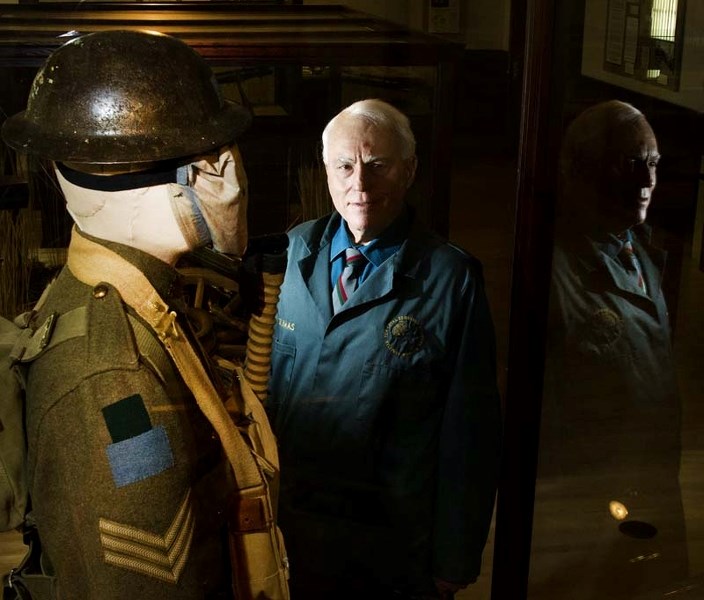Go down and stand in front of the St. Albert cenotaph on St. Anne Street and you will see the names of five St. Albert boys who were killed during the First World War: brothers John and Dan Kennedy, cousins Harry and Clarence Maloney and Albert Goodman.
The loss of those five men would have been deeply felt within the small community of St. Albert. The 1911 census shows St. Albert had a population of just 614 people. To put that in perspective, today the combined student and staff population of St. Albert Catholic High School is approximately 600.
Joint funerals were held in St. Albert for Dan Kennedy and Harry Maloney, both of whom died in September 1916. Just six days later, Clarence Maloney died. John Kennedy died at Vimy Ridge on April 9, 1917 and finally, Albert Goodman died in 1918.
"Everyone would have known them and their deaths would affect every family. The impact would have been great because there were a great many marriages between families. And imagine the impact for the Kennedy boys' mother, who lost two sons," said Shari Strachan, director of the Musée Heritage Museum.
It's unclear from the Black Robe's Vision, St. Albert's history book, whether any of the men were married or had children. The history book doesn't tell us what skills they had or what ambitions or wishes they held close to their hearts. Nor does it speculate upon what they might have done with their lives.
Loyal Eddies
It's that loss of potential manpower that bothers St. Albert historian David Haas the most. Haas spent four years studying the First World War and curated an exhibit entitled C100: Canada's Last Hundred Days at the Loyal Edmonton Regiment Museum.
"No one knows the exact total of how many died in the First World War but it would be well into the millions. A total of 60,000 Canadians died," said Haas, who is a retired lawyer as well as a retired major from the Loyal Edmonton Regiment (Loyal Eddies) reserve unit.
Haas has personalized the exhibit by displaying items like the letters that were sent home to mothers after their sons had been killed in action.
One envelope which is displayed was from the War Office. It was addressed to a Mrs. Susan Boyd but she never opened it and it remained unopened until her grandson finally looked inside it after she died. It was a notice telling Mrs. Boyd that her son had died.
"They knew what it was and so they didn't open it. They had already been sent another letter in a similar envelope when another son died and her grandson told me they couldn't bear to open this one," Haas explained.
Guns and military equipment, including gas masks, that would have been used by both German and Allied troops are displayed. The life-like statue of a soldier in uniform shows the rig that the Canadian soldiers wore in battle.
"Each soldier carried 70 pounds," Haas said.
Haas chose to highlight the battles of the last 100 days of the First World War, to show the key role Canadians played in the final victory.
In 1918 the Germans changed their tactics and instead of attacking the strong point of the Allied defences they began to attack weak points. The Canadians, who had a smaller army than the British, copied some of the German methods to make the most of their men, Haas said.
"The Canadians had more concentrated troops including the 49th Battalion with men from the Edmonton area. The Canadians also had more machine guns than the British," Haas said.
The Black Robe's Vision records that the Kennedy boys fought with the 49th Battalion but the history book does not list whether the other men who died were in the same unit.
Canadian pride
No single battle won the war Haas said, but a final Allied offensive at Mons, Belgium on Nov. 11, 1918 ended the conflict. Canadians, including men from the 49th Battalion, fought in that battle. A bugle, on display at the exhibit, was blown at Mons at 11 a.m. to signal the ceasefire.
"The legacy of those last 100 days is that one-fifth of the war's Canadian casualties happened then," Haas said, as he acknowledged that the contribution made by the St. Albert soldiers was huge.
"Little St. Albert lost its young manhood in that war. And what would have happened here in St. Albert, happened everywhere. The supply of men for husbands was short. Even many years later, well into the 1960s, when I was in London, there were still memorials in the London Times about men who had died in the First World War. People were still grieving," Haas said.
Much has been written about the First World War being the turning point in history that made Canadians feel nationalistic, but Haas believes it was the returning soldiers who did the most to bolster Canadian pride.
"At home there was still a powerful sense of the whole pride in the British Empire thing," Haas said. "But the day those soldiers became part of the Canadian army they wore a maple leaf. They also didn't much like British officers. The pride in being Canadian was most definitely brought home by the soldiers."
Loyal Edmonton Regiment Museum
Located in the Prince of Wales Armoury at 10440 108 Ave. in Edmonton.
Open Mon., Tues., Thurs. and Fri. from 10 a.m. to 4 p.m. Wed. hours: 10 a.m. until 8 p.m.
Nov. 11 the museum will be open from 10 a.m. to 3 p.m. The exhibit will continue into 2014 to mark the 100th anniversary of the beginning of the First World War.




